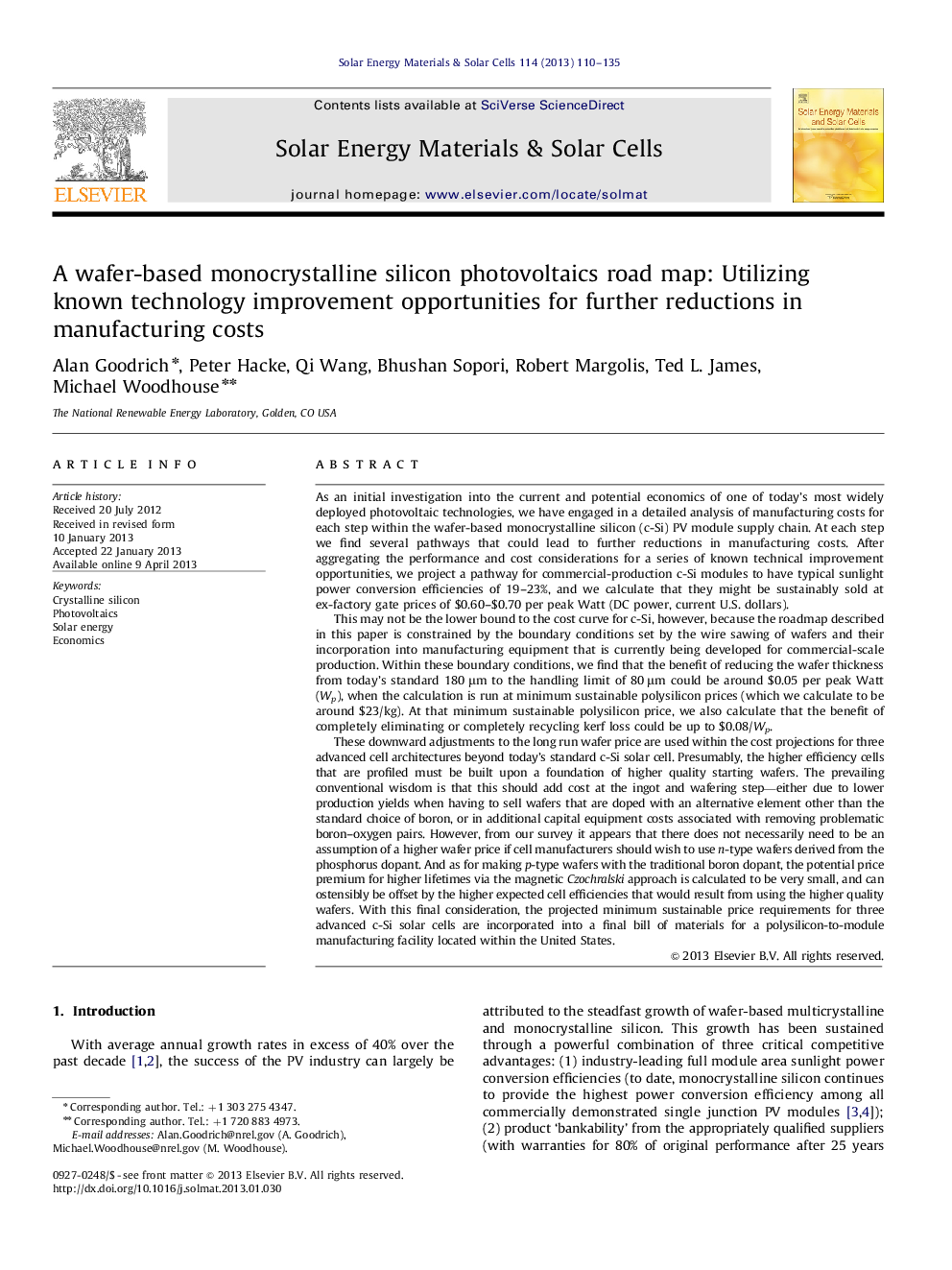| Article ID | Journal | Published Year | Pages | File Type |
|---|---|---|---|---|
| 78498 | Solar Energy Materials and Solar Cells | 2013 | 26 Pages |
As an initial investigation into the current and potential economics of one of today's most widely deployed photovoltaic technologies, we have engaged in a detailed analysis of manufacturing costs for each step within the wafer-based monocrystalline silicon (c-Si) PV module supply chain. At each step we find several pathways that could lead to further reductions in manufacturing costs. After aggregating the performance and cost considerations for a series of known technical improvement opportunities, we project a pathway for commercial-production c-Si modules to have typical sunlight power conversion efficiencies of 19–23%, and we calculate that they might be sustainably sold at ex-factory gate prices of $0.60–$0.70 per peak Watt (DC power, current U.S. dollars).This may not be the lower bound to the cost curve for c-Si, however, because the roadmap described in this paper is constrained by the boundary conditions set by the wire sawing of wafers and their incorporation into manufacturing equipment that is currently being developed for commercial-scale production. Within these boundary conditions, we find that the benefit of reducing the wafer thickness from today's standard 180 μm to the handling limit of 80 μm could be around $0.05 per peak Watt (Wp), when the calculation is run at minimum sustainable polysilicon prices (which we calculate to be around $23/kg). At that minimum sustainable polysilicon price, we also calculate that the benefit of completely eliminating or completely recycling kerf loss could be up to $0.08/Wp.These downward adjustments to the long run wafer price are used within the cost projections for three advanced cell architectures beyond today's standard c-Si solar cell. Presumably, the higher efficiency cells that are profiled must be built upon a foundation of higher quality starting wafers. The prevailing conventional wisdom is that this should add cost at the ingot and wafering step—either due to lower production yields when having to sell wafers that are doped with an alternative element other than the standard choice of boron, or in additional capital equipment costs associated with removing problematic boron–oxygen pairs. However, from our survey it appears that there does not necessarily need to be an assumption of a higher wafer price if cell manufacturers should wish to use n-type wafers derived from the phosphorus dopant. And as for making p-type wafers with the traditional boron dopant, the potential price premium for higher lifetimes via the magnetic Czochralski approach is calculated to be very small, and can ostensibly be offset by the higher expected cell efficiencies that would result from using the higher quality wafers. With this final consideration, the projected minimum sustainable price requirements for three advanced c-Si solar cells are incorporated into a final bill of materials for a polysilicon-to-module manufacturing facility located within the United States.
Graphical abstractTop: Cost model results for completed modules: a compilation of estimated costs for manufacturing standard modules and advanced modules within the full c-Si supply chain, assuming all products are transferred at minimum sustainable prices. The numbers underneath each cell type indicate the assumed module efficiency and wafer thickness for each. The long-term scenario reflects the projected costs and prices for modules made with cells on 80 μm wire-sawn kerfless wafers at minimum sustainable polysilicon prices (see Fig. 5 and Fig. 11). Bottom: The efficiency-adjusted module prices for the different cell types, in consideration of balance-of-systems savings (HIT and IBC), or costs (Standard and Tech Group 1). The BOS efficiency adjustments to module price are normalized against the 20% module efficiency targeted within the U.S. Department of Energy's SunShot Initiative.Figure optionsDownload full-size imageDownload as PowerPoint slideHighlights► Numerous pathways are still available for c-Si modules to have higher sunlight power conversion efficiencies and reduced manufacturing costs. ► For each step within the c-Si module supply chain, a ‘bottoms-up’ analysis is provided for 2012 and projected manufacturing costs. ► The cost benefits of improved silicon utilization are shown. ► As examples of how c-Si cell efficiencies might be improved, three advanced cell architectures and manufacturing process flows are shown. ► These cells are incorporated into a projected final module cost.
